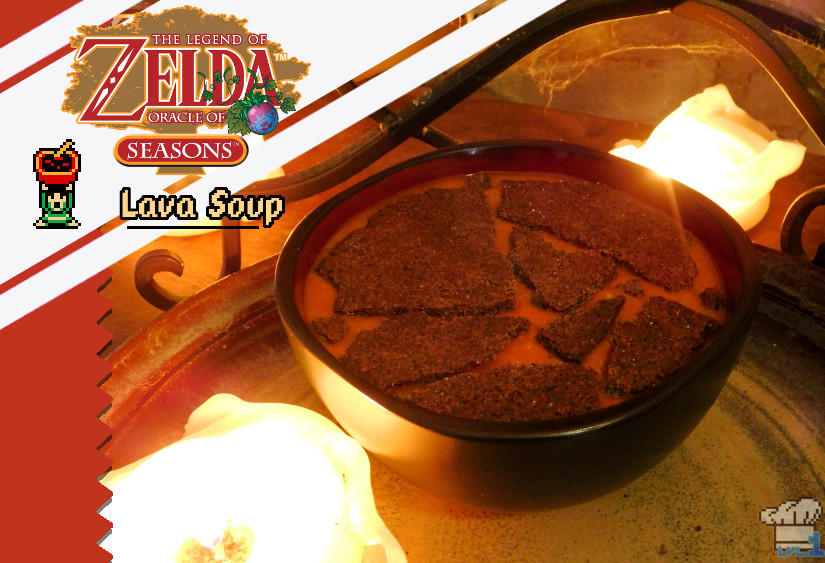
It’s November again and that means Zelda Month! If you’ve been reading the blog for a while you know that I’ve been a big supporter of this unofficial month-long celebration for the past three years. So, in honor of that, and the fact that it’s been getting pretty darn chilly up in my neck of the woods, I think the Lava Soup from the Legend of Zelda: Oracle of Seasons would be the perfect mid-November recipe.
Many of you might remember last year’s Zelda Month during which I hosted a recipe blog linkup for the Fandom Foodie community, but for those of you new here, here’s a little history. Zelda Month has its origins on Youtube, specifically from a guy called PeanutButterGamer who would put out exclusively Zelda themed videos throughout the month of November. That was several years ago and the trend has only gotten bigger since then inspiring other content creators such as myself to produce Zelda stuff in November. Although he’s taking this year off to focus on a ‘Mario Month’ of videos, I still felt like I should put out at least one Zelda themed recipe to keep the tradition going.
With its strong focus on food, I ended up putting out quite a few recipes from the Legend of Zelda: Breath of the Wild earlier this year (and there are definitely more cool dishes where those came from) but I was interested in seeing what some of the lesser known Zelda titles might have to offer as well.
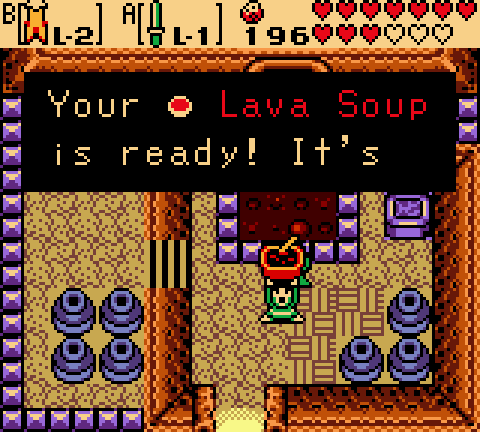
The suggestion to make Lava Soup from the Legend of Zelda: Oracle of Seasons actually came via twitter from my friend Martin and I knew right away that it’d be perfect for this year’s Zelda Month. In the game, Link acquires the Lava Soup as part of a trading quest after he gives the Subrosian Chef the Iron Pot. Unfortunately, there’s no way to actually consume this soup as Link, but when you deliver this piping hot soup to Biggoron on top of Goron Mountain, his head cold is immediately cured! We can imagine that this soup has some strong properties indeed.
The birthplace of this blistering cuisine is a place called Subrosia, an underground world full of magma and fire. So just in case the name lava soup wasn’t enough of a giveaway, we know this soup has got to be hot! But, because I don’t want anyone actually burning their mouths on this stuff, our lava soup is going to be other kind of hot, the spicy kind!
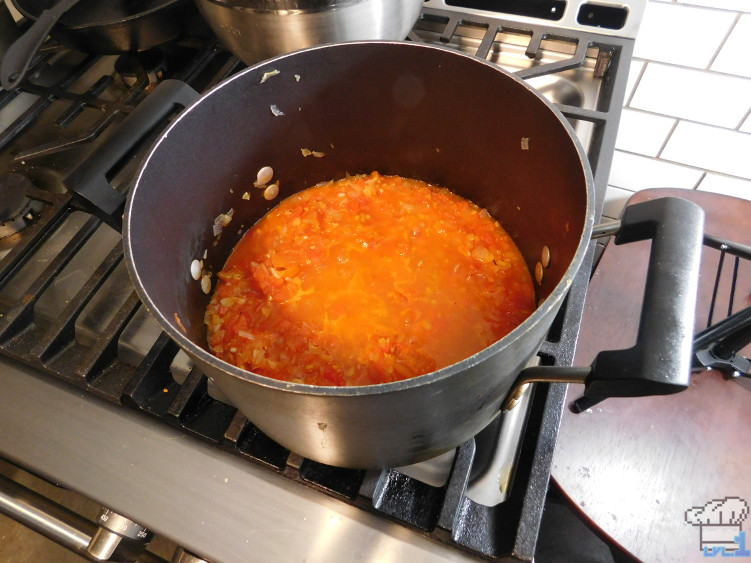
As with several of my recipes, I start with something basic and then try to incorporate certain ingredients or change the way the finished product looks to be more faithful to the game. For the lava soup, I knew I was going to start out with a tomato soup and then spice it up with some peppers. I tried out adding 10 whole habeñero peppers to the soup during one of my cooking live streams and the results were almost too spicy to eat! (but probably really fun to watch me suffer through.) That being said, the soup recipe still involves habeñeros, but I’ve reduced the amount significantly haha.
The next challenge was to make the whole thing look like lava. Sure, the orangey red color from the soup would look fine, but taking another glance at the sprite, the soup in almost totally black! This made me think of lava block flows where you have the super hot fluid orange magma under a layer of cooled black lava rock. That certainly makes sense, but how do we make the rocks?

Why, black beans of course! I’ve been wanting to make something out of black bean flour for a while and this seemed like the perfect opportunity. My original plan was to make chips, similar to ‘Beanitos,’ but after a little trial and error it seemed that black bean crackers would hold up a little better (and who doesn’t like soup and crackers!?)
The result was a spicy orange soup with a dark crunchy top. Looks like lava to me! I should say that this recipe could be made very easily by using canned tomatoes and other convenience products, but as you’ll see below, I took the opportunity to teach some pretty cool culinary techniques with fresh ingredients. Either way, I hope you all like the soup regardless of how you make it! Thanks again to Martin for the recipe suggestion! I’m always open to them, so feel free to drop me a line (such as in the comments below) any time!
+ Lava Soup +
makes about 1 quart
ITEMS
| Ingredient | Amount |
|---|---|
| Tomatoes | 3 lbs (about 10 vine tomatoes) |
| Onion | 1 large |
| Garlic | 4 cloves |
| Red Bell Peppers | 2 |
| Habeñero Peppers* | 2 oz (about 5 peppers) |
| Salt | 2¼ tsp |
| Pepper | to taste |
| Vegetable Oil | 2 Tbsp. |
| Lime Juice | 1 Tbsp. |
*Habeñeros are pretty stinkin’ hot. In the original recipe I used 10(!) and it was nigh inedible so I reduced the habeñeros by half to only 5 per recipe as a fair starting point. Feel free to decrease or increase this number depending on how much you enjoy spicy food, but PLEASE don’t overdo it! Also these peppers can really irritate your mucus membranes as well as your… more sensitive areas, so be sure to use gloves or at the very least wash your hands thoroughly after handling them.
EQUIP
- Sharp knife and cutting board
- A few mixing bowls
- Large, heavy bottomed pot with lid
- Slotted spoon
- Strainer or colander
- Metal tongs (optional)
- Immerssion blender or food processor
WALKTHROUGH
Note: If you are planning on making the black bean crackers as well, skip down a ways to that recipe and start drying out the beans. By the time you’re done with the soup here they should be ready to go!
1) You could easily make this soup with canned crushed tomatoes, but I thought this recipe would be the perfect opportunity to demonstrate a really cool and pretty darn fancy culinary technique known as ‘concasse.’ (It’s pronounced con-keh-say.) This is a technique that helps with the peeling and de-seeding of tomatoes for use in soups and other dishes. This was something I learned in my first semester in culinary school, so it’s pretty ubiquitous in classic cuisine.
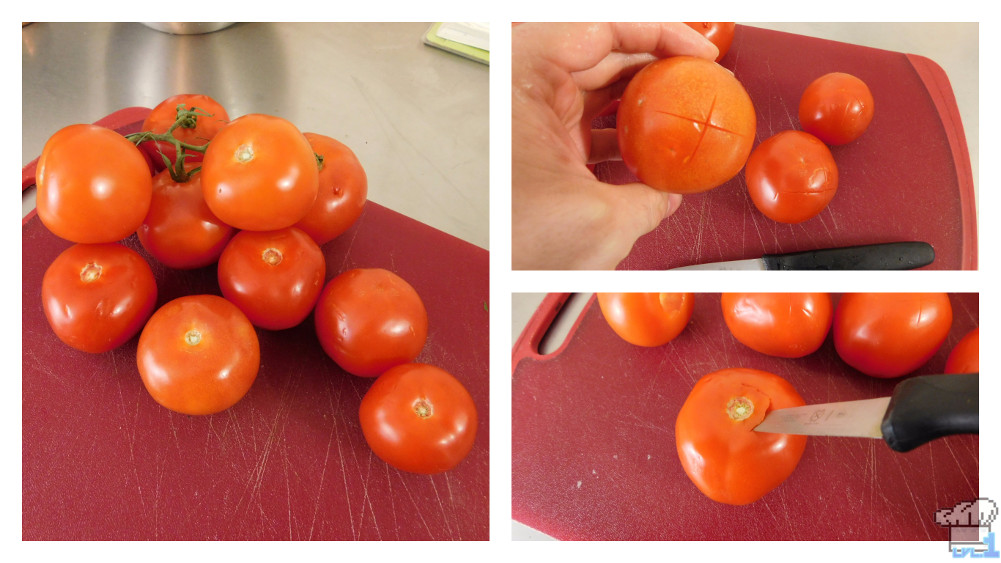
2) The first thing you want to do is fill a large stock pot halfway with water and bring it to a boil over high heat. While that’s warming up, use a sharp, small knife to cut a shallow ‘X’ across the skin of each tomato. Next, use the knife to remove the stem end of the tomatoes as shown above.
3) Once the water is at a rolling boil and your tomatoes are prepped, carefully place about 5 tomatoes into the pot and let them cook for 45 seconds to one minute. Remove the tomatoes from the hot water with a slotted spoon and transfer them to a large mixing bowl. Run some cold water over them to stop the cooking process. Repeat these steps with the remaining 5 tomatoes and once they’ve all been heated and cooled, remove the pot of water from the heat.
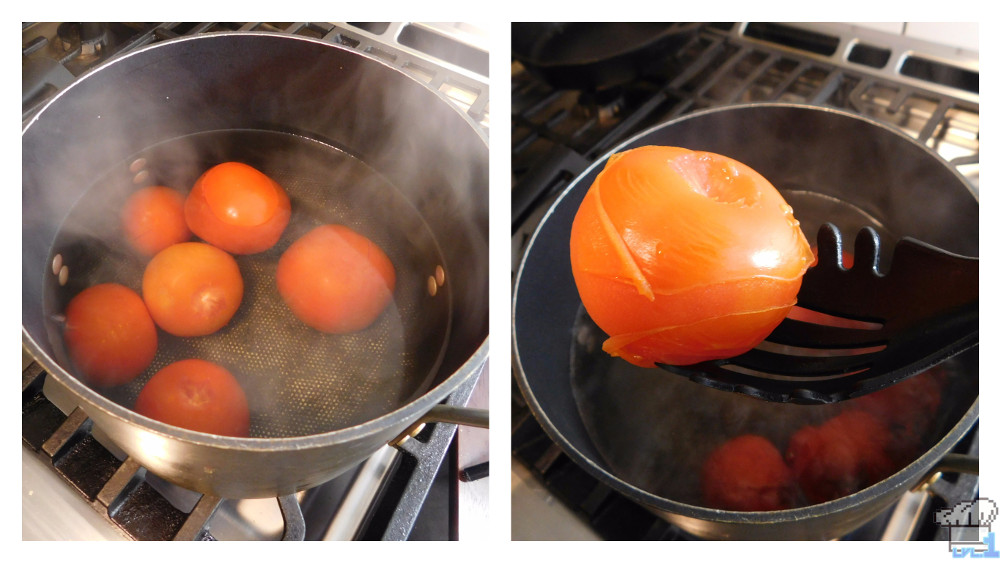
4) After the tomatoes have cooled down enough to handle, you can begin to peel the skin off. You can see in the photo above, that the ‘X’s we cut into the tomatoes help give us a good start. Next, slice the tomatoes in half cross-ways (i.e. not top to bottom) and lay them with the seeds facing upwards. Using your small, sharp knife, cut across the light colored membranes, separating the seeds from the inner walls. You can use your fingers to remove the seeds, but don’t throw them out just yet. Instead, place the seeds in a strainer over a small mixing bowl in order to collect the ‘tomato water” which we can add back into the soup later. As for the seedless tomato pieces themselves, they can be roughly chopped and set aside while we prep the other veggies.
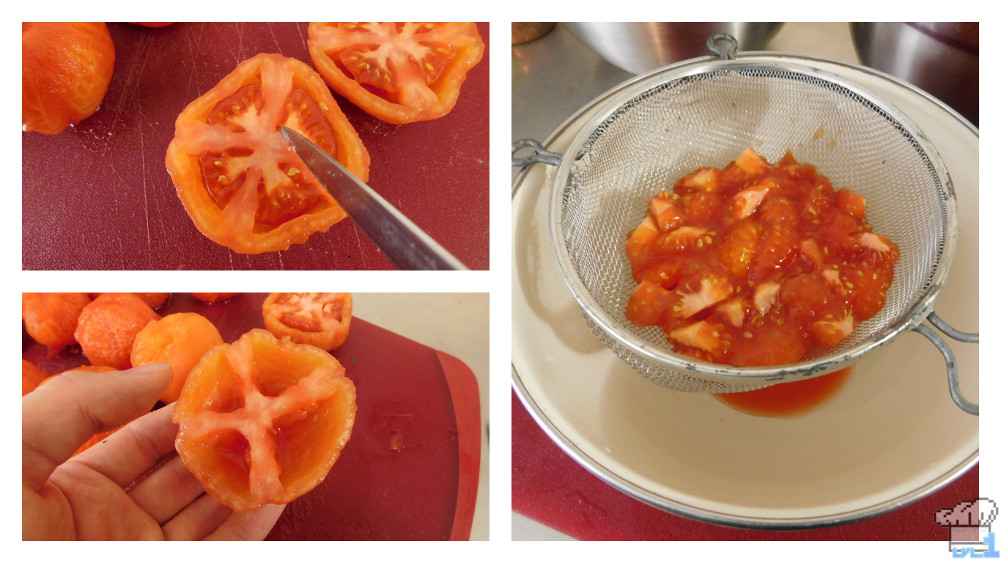
5) This next step is optional, because not everyone has a gas stove, but if you want to fire-roast your red peppers, here’s how you do it. Turn your burner flame to medium high and use metal tongs to carefully situate the two peppers above it. As the thin skin of the pepper begins to blister and burn, use the tongs to turn the peppers until they are almost completely black. After roasting, turn off the heat and transfet the peppers to a medium sized bowl and run them under cold water. Use your fingers to rub away as much of the burned skin as possible.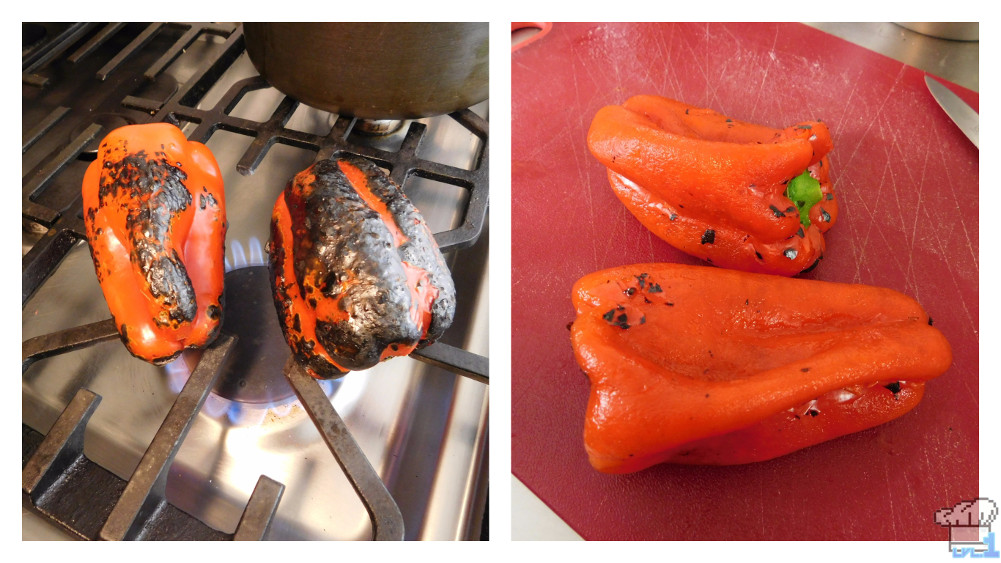
6) Cut the red peppers as well as the habeñeros and remove all the seeds. I find the easiest way to do this is to slice off one ‘wall’ at a time and more or less avoid the central seed pod completely. Seeds are extra spicy and don’t necessarily taste good to chomp down on, so we don’t want them around. Finish the veggie prep by roughly chopping your peppers as well as the onion and the garlic.
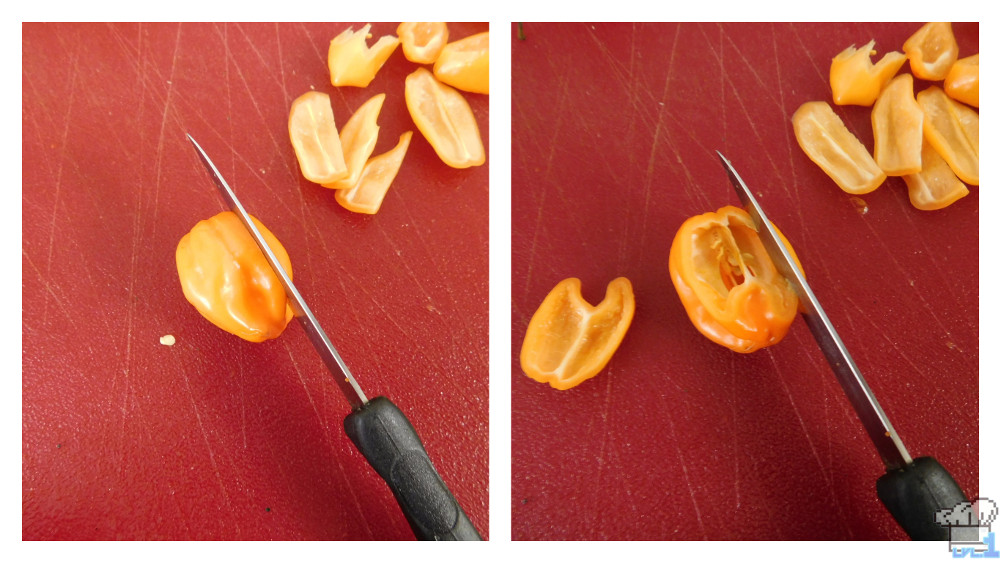
7) In a large stock pot over medium heat, add your chopped onion along with 2 Tbsp of vegetable oil. Cook the onion down until soft (about 3-4 minutes) and then add the garlic. Heat the onions and the garlic for another two minutes being careful not to brown them before adding the tomatoes and peppers into the pot as well. Stir in the salt and pepper. Cover the pot and let the soup simmer for 15 minutes.
8) Remove the soup from the heat and stir in the 1 Tbsp of lime juice as well as the tomato water we had been collecting. Let it cool for a few minutes before using an immersion blender or a food processor to blend it relatively smooth. If you find it’s a little thick after the blend and more sauce than soup, feel free to thin it out with a little water or vegetable stock to reach your desired consistency. Careful, this stuff is HOT!
+ Black Bean Crackers +
ITEMS
| Ingredient | Amount |
|---|---|
| Canned Black Beans | 2 15 oz cans |
| AP Flour | ½ cup |
| Smoked Paprika | 1 tsp |
| Garlic Powder | ½ tsp |
| Salt | ½ tsp, plus more for topping |
| Butter | 6 Tbsp. |
| Shredded Cheese* | ½ cup |
| Milk | 6 Tbsp. |
*I used shredded queso, but I think mozzarella and other cheeses would work just as well
EQUIP
- Sharp knife and cutting board
- A few mixing bowls
- Cookie sheet or baking pan
- Spice/coffee grinder
- Food processor
- Parchment paper
- Rolling pin
WALKTHROUGH
1) First things first, open the two cans of black beans and rinse them completely. Place them on a baking stray lined with paper towels in order to absorb as much water as possible. Leave them to dry out for a bit while you make the soup!
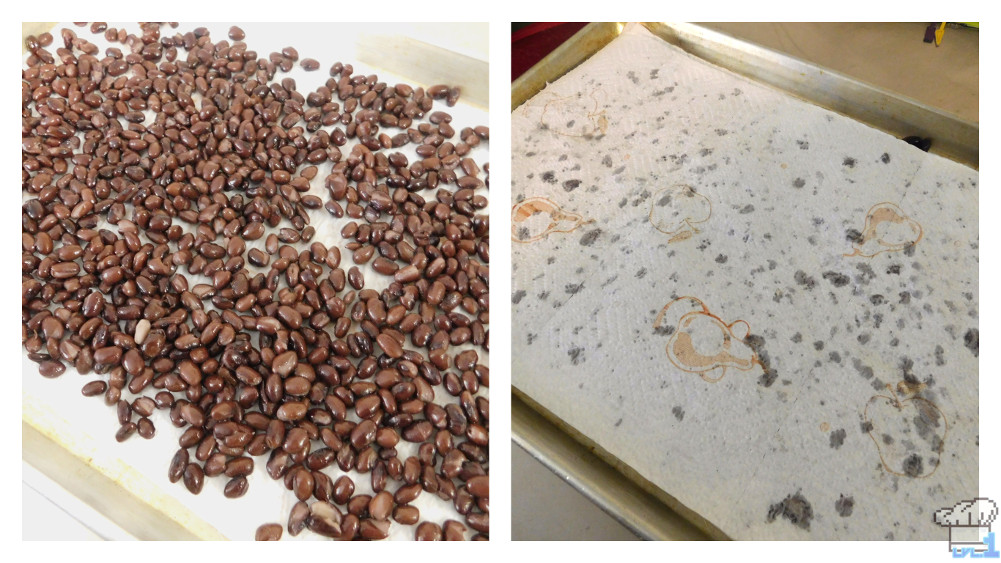
2) Preheat the oven to 350°F. Toss the mostly dry beans in a little bit of oil and pour them on to a parchment lined baking pan. Once the oven is ready, bake the beans for 15 minutes or until split and brittle.
3) Use a spice or coffee grinder to buzz up the dried black beans into a powder. Congratulations, you’ve made black bean flour! Pour the flour into a food processor along with the AP flour, spices, and salt, and pulse to combine. Cut up the butter into small cubes and cut them into the flour mixture with several short pulses. Add the ½ cup of cheese and pulse until completely combined.

4) To finish the black bean cracker dough, pour in the 6 Tbsps of milk and process until everything comes together into a ball. Remove the dough ball from the food processor and place it on a sheet of parchment paper on your work area. Cover it with another sheet of parchment and use a rolling pin to roll out the dough to a thickness of about 1/8″ to 1/4.” Remove the top sheet of parchment and use a fork to poke several holes into the dough to let steam escape; this is called docking the dough. Finally, slide the cracker dough and parchment paper on to a baking sheet and bake in the oven for 20 minutes until crisp.

5) Let the cracker cool and then break it up into large pieces in order to form the cracked block lava flows on top of the soup!
Hey! Thanks for reading all the the way to the end! You’re awesome :D! If you haven’t already and are looking for more nerdy food stuff, consider following me on Twitter, Facebook, tumblr and Instagram. I post a lot of work in progress pictures for the blog as well as stuff from my Twitch streams. If that sounds like something you’d be into, please check out those links above! Anyway, take care everyone and I’ll see you next time with an all-new recipe!
I also have a Patreon page where fans like you can help support me directly! There are some pretty cool rewards in it for you as well so you’ll definitely want to check it out :].
A huge thanks to everyone who has supported me so far!
Chets Y., Charlotte G., Tyler S., Derek R., Dan S., Victoria , Kurt P., Fox Corp., Archy Dan, The Gluttonous Geek, Josh M., Val C., Katharina, Daniel L., and Amanda B.

